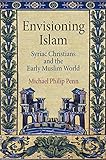Envisioning Islam : Syriac Christians and the Early Muslim World / Michael Philip Penn.
Material type: TextSeries: Divinations: Rereading Late Ancient ReligionPublisher: Philadelphia : University of Pennsylvania Press, [2015]Copyright date: ©2015Description: 1 online resource (304 p.)Content type:
TextSeries: Divinations: Rereading Late Ancient ReligionPublisher: Philadelphia : University of Pennsylvania Press, [2015]Copyright date: ©2015Description: 1 online resource (304 p.)Content type: - 9780812247220
- 9780812291445
- Christianity and other religions -- Islam -- History -- To 1500
- Christianity and other religions -- Islam -- History -- To 1500
- Islam -- Relations -- Christianity -- History -- To 1500
- Islam -- Relations -- Christianity -- History -- To 1500
- Syriac Christians -- History -- To 1500
- Syriac Christians -- History -- To 1500 -- To 1500
- Syriac Christians -- History -- To 1500
- Religious Studies
- RELIGION / Christian Church / History
- Ancient Studies
- History
- Religion
- Religious Studies
- 275.6/03 23
- online - DeGruyter
- Issued also in print.
| Item type | Current library | Call number | URL | Status | Notes | Barcode | |
|---|---|---|---|---|---|---|---|
 eBook
eBook
|
Biblioteca "Angelicum" Pont. Univ. S.Tommaso d'Aquino Nuvola online | online - DeGruyter (Browse shelf(Opens below)) | Online access | Not for loan (Accesso limitato) | Accesso per gli utenti autorizzati / Access for authorized users | (dgr)9780812291445 |
Browsing Biblioteca "Angelicum" Pont. Univ. S.Tommaso d'Aquino shelves, Shelving location: Nuvola online Close shelf browser (Hides shelf browser)

|

|

|

|

|

|

|
||
| online - DeGruyter The Life of Benjamin Franklin. Volume 3, The Life of Benjamin Franklin, Volume 3 ; Soldier, Scientist, and Politician, 1748-1757 / | online - DeGruyter The Human Right to Citizenship : A Slippery Concept / | online - DeGruyter The Markets for Force : Privatization of Security Across World Regions / | online - DeGruyter Envisioning Islam : Syriac Christians and the Early Muslim World / | online - DeGruyter Rendering Nature : Animals, Bodies, Places, Politics / | online - DeGruyter Culture and PTSD : Trauma in Global and Historical Perspective / | online - DeGruyter From Eden to Eternity : Creations of Paradise in the Later Middle Ages / |
Frontmatter -- Contents -- Introduction -- Chapter 1. When Good Things Happened to Other People: Syriac Memories of the Islamic Conquests -- Chapter 2. A Different Type of Difference- Making: Syriac Narratives of Religious Identity -- Chapter 3. Using Muslims to Think With: Narratives of Islamic Rulers -- Chapter 4. Blurring Boundaries: The Continuum Between Early Christianity and Early Islam -- Conclusion -- Notes -- Bibliography -- Index -- Acknowledgments
restricted access online access with authorization star
http://purl.org/coar/access_right/c_16ec
The first Christians to encounter Islam were not Latin-speakers from the western Mediterranean or Greek-speakers from Constantinople but Mesopotamian Christians who spoke the Aramaic dialect of Syriac. Under Muslim rule from the seventh century onward, Syriac Christians wrote the most extensive descriptions extant of early Islam. Seldom translated and often omitted from modern historical reconstructions, this vast body of texts reveals a complicated and evolving range of religious and cultural exchanges that took place from the seventh to the ninth century.The first book-length analysis of these earliest encounters, Envisioning Islam highlights the ways these neglected texts challenge the modern scholarly narrative of early Muslim conquests, rulers, and religious practice. Examining Syriac sources including letters, theological tracts, scientific treatises, and histories, Michael Philip Penn reveals a culture of substantial interreligious interaction in which the categorical boundaries between Christianity and Islam were more ambiguous than distinct. The diversity of ancient Syriac images of Islam, he demonstrates, revolutionizes our understanding of the early Islamic world and challenges widespread cultural assumptions about the history of exclusively hostile Christian-Muslim relations.
Issued also in print.
Mode of access: Internet via World Wide Web.
In English.
Description based on online resource; title from PDF title page (publisher's Web site, viewed 30. Aug 2021)


